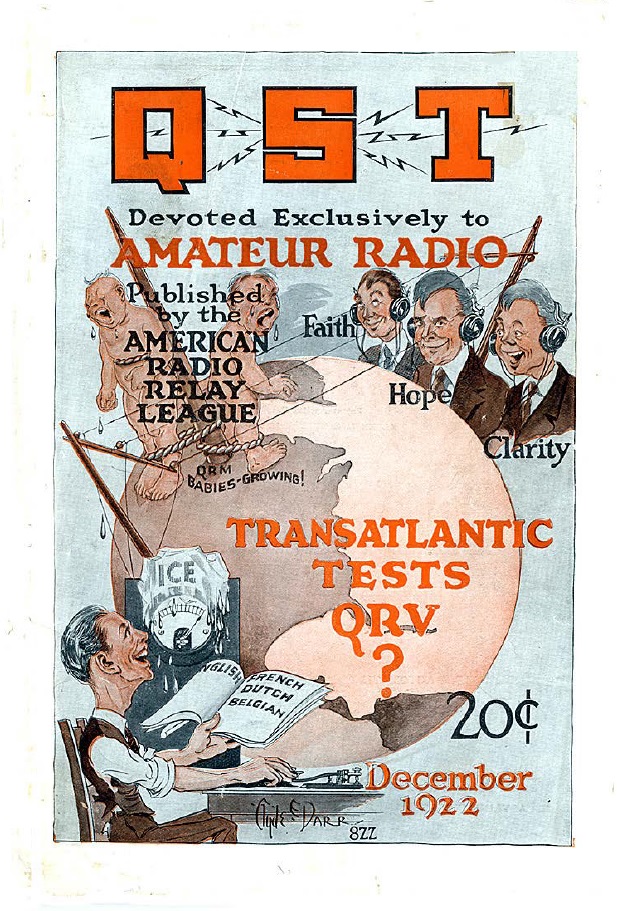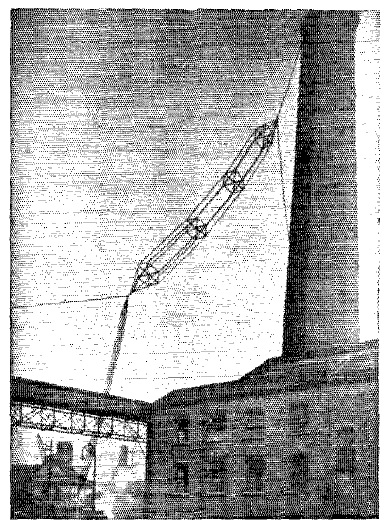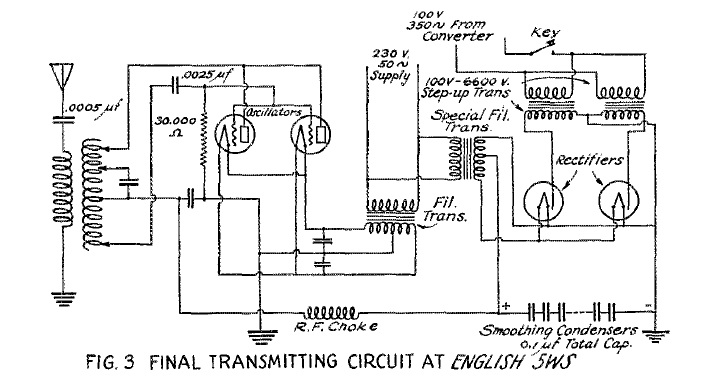Transatlantic Tests 3
Europe is heard in North America
After the euphoria surrounding the successful reception in Europe of amateur signals from North America, a third series of tests were planned for December 2022, with high hopes that a big step towards two-way Transatlantic communication could be made. The recently renamed RSGB, were keen to be heard on the other side of the pond and Philip Coursey set about creating a high-power amateur station to achieve this.
From QST, the ARRL journal, October 1922:
The ARRL Transatlantics 1922
Fellows, we’re going to have some more trans-ocean tests. Our ARRL Operating Department will conduct the third series of Trans-Atlantic Tests with the co-operation of the English, French, and Dutch amateurs, in December of this year. While no definite dates for the final tests have been decided upon, pending suggestions from England, France and Holland, the probable dates are December 12th to December 31st, inclusive. During the first ten days of the tests American and Canadian Amateurs will transmit signals for reception in England, France and Holland.[1]
And Wireless World, 21 October 1922:
More Transatlantic Tests for Amateurs.
American Radio amateurs, organised by the American Radio Relay League, conducted a series of signalling tests across the Atlantic in December last. The signals sent out by many of those American amateur stations were picked up in many parts of this country. Another series of similar tests is being arranged to take place towards the close of this year, when it is hoped that not only will it again prove possible to pick up signals from our American friends, but also that by means of two or three specially equipped stations in this country it may be possible to reply to them. The tests on this occasion will embrace not only England and America but France, Belgium, Holland and probably Italy as well.[2]
Radio amateurs on both sides of the Atlantic were still using wavelengths around 200 metres and UK stations were only licensed to use low power and to have simple aerials. Special permits were requested from the Post Office, by a very few amateurs, to allow higher power to be used specifically for the tests. From Wireless World, 11 November 1922:
The Transatlantic Communication Tests.
The main object of the forthcoming transatlantic communication tests between American, Canadian, and European radio amateurs is not only to pick up signals from the other side of the Atlantic as was done last year, but also, if possible, to establish communication in both directions across the ocean solely between amateur stations, and using the amateur wavelengths. While arrangements are well in hand for the use of specially equipped transmitting stations in this country, during these tests, there are doubtless also many other amateur stations which have established long-distance signalling ranges, and which could therefore take part in the tests with some chance of success. It is very desirable that this country should have several transmitting stations in operation during the tests in order to give the Americans plenty of signals to listen for. Several French stations will also be transmitting.
As in last year’s tests the transmissions from America and Canada will be sent on the usual American amateur wavelengths in the neighbourhood of 200 metres, and also on the special wavelengths in the neighbourhood of 365 metres, which are licensed to some of their stations. Transmissions will take place during a period of approximately five hours on each night, the stations taking part being allotted a different portion of the five hours period on successive nights.[3]

(Copyright ARRL, used with their kind permission)
Wireless World, 25 November 1922, gave encouragement:
From the latest information received from America in connection with these tests, it appears that even greater enthusiasm is being shown there on this occasion than last year.[4]
QST, November 1922, struck a similar tone:
Nothing in the history of amateur radio has stirred up so much enthusiasm among the radio amateurs as has the announcement of the third series of A.R.R.L. Transatlantic tests which appeared in October QST. Practically every amateur in the United States is brimming over with an eagerness for the night of the tests.
The tests will start on December 12th and end December 31st. American and Canadian amateurs will transmit for ten nights, beginning December 12th and ending December 21st. From December 22nd until December 31st, English and French Amateurs will transmit and American and Canadian Amateurs will listen. That will be our chance to show our skill in reception.[5]
As with the previous tests, receiving stations were to report back using commercial radio telegrams and the results would be forwarded on by amateurs. A request was made to US amateurs, to keep their transmitters absolutely silent during the last ten days of the tests, December 22 to 31, inclusive, midnight to 0600 GMT, when they would listen for French and English amateurs. “In the name of good sportsmanship we ask, every American and Canadian amateur to QRT during our reception periods.” As previously, Fred Schnell, Traffic Manager for ARRL, coordinated activities for the ARRL and Philip Coursey for the RSGB.
Wireless World, 23 December 1922, confirmed that many US and Canadian stations had been heard in the first 10 days of the tests:
At the time of writing, reports are just beginning to arrive of the receptions of the American transmissions during the first night of the Transatlantic Tests. Reports have already been received from several parts of this country and also from Holland showing that several US amateurs have “got over”, their signals with the special code words allotted to them having been received and verified by the copy of the transmission schedule which was sent to the Radio Society of Great Britain by the American Radio Relay League.
During the “Individual transmission” periods signals complete with correct code letters were picked up from the following U.S. stations:
1BGF; 1YK; 2EL; 2GK; 2NZ; 2XAP; 2ZK; 2ZL;3ZW; 8AQO; 8AWP.
And also that during the “free-for-all” transmission periods the following stations were heard, signalling “Test, Test, Test” at their correct times in accordance with the prearranged schedule:
2BML (Harold Beverage); 2LK; 2NZ; 2ZK; 3BGT; 3HG; 3ZY; 4FB;4OI; 4ZS; 4ZW.[6]
Then came the East-West tests, from 22 to 31 December and for this the RSGB assembled a high power amateur station as described later in Wireless World, 20 January 1923:
The Erection of 5WS – The Radio Society Special Station at Wandsworth
It could, of course, hardly be expected that the amateur stations complying with the ordinary Post Office regulations would be able to reach through to America from Great Britain, but for the period of the tests, viz., December 22nd to 31st, several special licenses were issued permitting the holders to use increased power, and to erect larger aerials. Amongst those so favoured was the Radio Society of Great Britain, which was represented by a specially appointed sub-committee, including Messrs G G Blake, P R Coursey, N Hamilton, N Lee and C F Phillips, and these members were later joined by Mr. M Child. Having no club rooms or regular transmitting station of any kind the first matter to be considered was a suitable location for the special station to which the call letters 5WS were to be assigned. Several proposals were tentatively examined, but all proved impracticable, until Mr. Blake approached the Engineer of the Generating Station at Richmond, with a view to the possible use of a site at their station. Some such situation was desirable, since the provision of a suitable power supply was essential. While the Richmond engineers were themselves unable to help, they suggested that application should be made to the County of London Electric Supply Company. Mr Bacon, the Chief Engineer, was therefore approached, and proved very sympathetic. Through his kindness the matter was put before the directors of the company and their consent to the use of a site quickly obtained. Permission was given for the use of a chimney stack of their Wandsworth Generating Station, to support the aerial.
The aerial was a six-wire cage, having an overall length, including the lead-in wires, of approximately 160 feet. As the apparatus was put together rather roughly, owing to the shortage of time, it was necessary for one of the four who had been responsible for its arrangement to be present each night, in order to see that all was in order.
On one or two occasions the key of the hut was not forthcoming at the proper moment, but fortunately such a trivial matter was not allowed to stand in the way of progress, as the intrepid scientists gained an entrance through a very small window.
As a matter of interest, it may be stated that the aerial energy from 5WS was greater than that put out by 1BCG, the special station erected in America, during the 1921 tests, which was received by so many listeners over here.[7]

The 5WS aerial at Wandsworth – originally published in Wireless World, 20 January 1923
Wireless World, 24 February 1923 reported on the successful reception of the RSGB station (G)5WS on 24 December 1922.
Transatlantic Tests.
Results of British and French Transmissions, 1922.
As has already been announced in these columns, during the second part of the Transatlantic Tests between December 22nd and 31st, British and French radio amateurs transmitted test signals to America and Canada. All the British stations which were allocated special transmitting periods were given a code word in order to verify their receptions. The French transmitters also had code words, but arranged their three-hour periods as free-for-all times during which any of their transmitters were free to operate. Some of the results of the American receptions were reported by radiogram via New Brunswick and Carnarvon during the tests.
December 25th.
“TWENTY FOURTH SIX AMATEURS REPORT FIVE WATCH SAIL* CODE VERIFIED XMAS MESSAGE COPIED STOP ALSO NOUGHT ONE FIVE SIX GREENWICH FIVE SAIL WATCH HEARD TRANSMITTING CODE ASSIGNED FIVE WATCH SAIL* CONGRATULATIONS STOP NO FRENCH SIGNALS RECORDED. SCHNELL.”
December 31st.
“THIRTIETH FRENCH EIGHT ABLE BOY HEARD ONE HOUR STEADILY CODE VERIFIED NO BRITISH SIGNALS. SCHNELL.”
The official report of the receptions has now been received from the traffic manager of the American Radio Relay League, under the following covering letter which may perhaps be of interest as throwing a little light upon the conditions under which the tests were carried on:
To the Sub-Committee of The Radio Society of Great Britain.
Gentlemen, We congratulate you! The Transatlantic Tests were highly successful, and on behalf of the members of the American Radio Relay League, I beg to extend our cordial thanks for your superb co-operation in making the tests successful.[8]
*The phonetic alphabet used was historic with “FIVE WATCH SAIL” representing 5WS, the RSGB station; 5WS was heard by: 1BFG, 1BQ, 1OR, 1XP, 1ANA, L D Warner, 3BEC, 2BBB, 1MO (Fred Schnell) and 3ADP.

(Originally published in Wireless World, 20 January 1923)
The confirmed reports showed that a total of 315 different United States and Canadian amateurs were heard across the Atlantic. The British heard a total of 161 different stations, the French and Swiss a total of 239, while 85 American calls were heard both in the British Isles and on the Continent. In the “west-bound” tests a total of about 20 different American amateurs heard European amateur signals, principally from British 5WS (RSGB team) and from French 8AB (Leon Deloy) and allegedly from British 2FZ.
Later, doubt was placed on the authenticity of 2FZ as an active British station, most likely actually being a US amateur, therefore the only British station unquestionably heard in America with verified code words and other transmission was the special station of the Radio Society of Great Britain 5WS, and the only French station heard was 8AB.
The RSGB station (G)5WS was undeniably the very first European amateur station verified to be heard on the west side of the Atlantic.
At the end of 1922, Transatlantic amateur radio signals had been heard from West to East and from East to West. As yet there had been no two-way amateur Transatlantic communication – no QSO as such – but clearly the dawn of international amateur radio communication was breaking. The following year would see more milestones reached as amateurs rapidly moved to adopt shorter wavelengths.
References
[1] F. H. Schnell, Traffic Manager, The A.R.R.L. Transatlantics, QST, October 1922, pp. 11-12
[2] Philip R Coursey, More Transatlantic Tests for Amateurs, Wireless World, 21 October 1922, p. 91
[3] Philip R Coursey, The Transatlantic Communication Tests, Wireless World, 11 November 1922, pp. 185-187
[4] Philip R Coursey, The Transatlantic Communications, Wireless World, 25 November 1922, pp. 276-277
[5] F. H. Schnell, Traffic Manager, Arrangements for 1922 Transatlantics, QST, November 1922, p. 22
[6] Philip R Coursey, The Transatlantic Tests, Wireless World, 23 December 1922, p. 415
[7] Philip R Coursey, The Erection of 5WS – The Radio Society Special Station at Wandsworth, Wireless World, 20 January 1923, pp. 525-527
[8] Philip R Coursey, Transatlantic Tests, Results of British and French Transmissions, 1922, Wireless World, 24 February 1923, pp. 689-692
Other pages in this section










